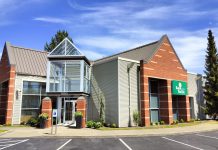If you research the toxicity of modern homes, you’ll quickly end up in a rabbit hole filled with subpar products, chemicals, and poisons that you and your family are exposed to every day. Not only are the majority of building products low quality and toxic, but the amount of water and energy the majority of homes waste is dizzying. A-1 Builders is on a mission to change the harmful and inefficient nature of our dwellings.
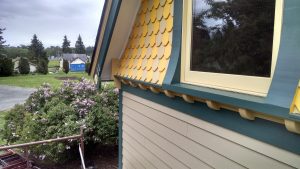
“When you start looking at individual stuff in people’s houses and start checking the level of toxicity for any one component—let alone 100 elements on one single floor—it’s a lot. It’s a big deal, and most builders have no interest in it,” says Patrick Martin, co-owner and general manager of A-1 Builders.
New products, technology, and building techniques are disrupting the traditional style of home building. Clients who care about the levels of toxicity and excess their homes create now have the option to build clean, strong structures or retrofit their existing homes in ways that aren’t inherently wasteful.
“High-performance homes are durable, sustainable and energy efficient,” says Maggie Bates co-owner and designer at A-1 Builders.
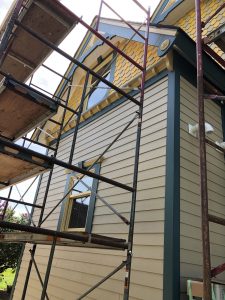
High performance goes beyond code compliance. It’s a commitment to creating better buildings that last longer and respect the environment. These homes utilize clean and efficient building materials and have a superior ventilation system to circulate fresh air throughout the house while keeping a constant temperature all year.
“Toxicity is not only in the products; it’s the systems, the forced air furnace and the ductwork that runs in your crawl space,” says Shawn Serdahl, co-owner in sales and design at A-1 Builders. “You’re sucking crawl space air as you heat your home.”
To meet energy standards of a high-performance home, you get ventilation, heat recovery, and amazing indoor air quality. The heat recovery ventilator (HRV) or an energy recovery ventilator (ERV) is the one component that solves many of the home toxicity problems.
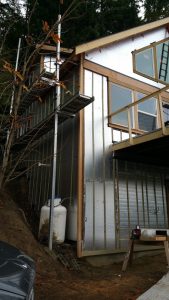
An ERV or HRV cycles fresh outside air through a ventilator, heating or cooling it, purifying it and adding or reducing moisture to keep the air at perfect levels while maintaining a constant cycle of fresh air running through the home.
A secure thermal envelope means the doors, walls, roof, foundation, and windows are built to reduce heat transfer from the inside to outside and vice versa throughout the seasons. This self-sustaining environment negates the highs and lows in temperature spikes that make your heater and air conditioner work overtime, expending more energy than necessary, and saves thousands of dollars in energy costs and unit repairs in the process.
A new substance called phase change materials (PCMs) can be added to the insulation of your home, which slows down the temperature loss in your walls and keeps the house cooler in the summer and warmer in the winter.
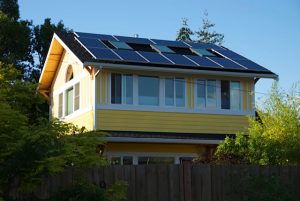
“I define high performance as something that’s efficient, comfortable, durable, easy to take care of and doesn’t poison you, the people who [built it], or your cat,” says Martin. “90% of homes in this community are toxic from indoor air quality.”
A thermal envelope, rainwater catchment systems, solar integration, purposeful design, and careful use of resources and materials are all contributors to a high-performance home. These factors create a long-lasting, sturdy, and sustainable house that pays for itself in energy efficiency, low water usage, clean air, and low maintenance.
A net-zero home is one that creates its own energy, eliminating the use of the power company and utilizing solar energy to generate enough power to run the home day to day.
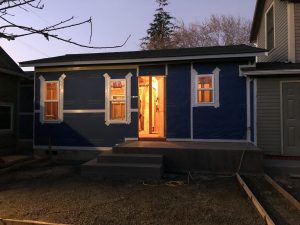
In the long run, the quality of materials and lack of upkeep without energy bills pay for itself in the new construction or retrofit of older structures when changing over to a high-performance home.
“Energy costs will never go down,” says Martin. “Even when we potentially transfer over to another system, the volume of need is out of proportion to what we can generate.”
High-performance homes are an investment in your future and the future of a sustainable environment. The problem with tract homes built to code is that the builders use the lowest quality of materials to recoup the most substantial profits. Often home buyers think they’re getting a deal with a brand-new home, only to be faced with expensive repairs just a few years after construction.
“There’s this mentality in society to think that new construction is going to require less maintenance because it’s a new house, but it’s the opposite,” says Serdahl. “They require more maintenance than an older house, and it usually happens within the first 10 or 15 years. In a new construction development, there’s no standard of energy or quality.”
One recent client came to A-1 Builders after moving into a brand-new condo in Fairhaven. Just a year and a half after construction, the unit developed multiple issues, including water and drywall damage.
We “use non-toxic materials that will last a long time with very little maintenance. That’s hard to find,” says Serdahl. “We have to be very careful about the products we choose in order to achieve that standard.”
A-1 Builders and their designers are working hand in hand with the Advanced Energy Institute and Western Washington University students on Project ZeNETH, a net zero tiny house project.
“It will have all of the components of a high-performance home with a super-efficient shell, and appliances and will generate all of its own energy use from a solar ray on the roof and use of water with a dispersion rain garden area,” says Martin.
Project ZeNETH is set to begin construction in July; their goal is to finish and park it next to the Huxley college by the fall of 2019.
“We know that our buildings consume 45% of energy and we have to fix that,” says Serdahl. “A high-performance home can start to change the way we use energy.”
If you’re interested in retrofitting your house or beginning construction on a new high-performance home contact A-1 Builders and Adaptations Design Studio.
A-1 Builders and Adaptations Design Studio
3310 Northwest Avenue in Bellingham
360-734-5249
www.a1builders.ws
Sponsored





















